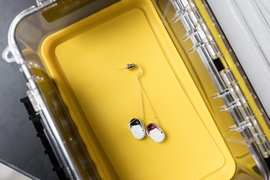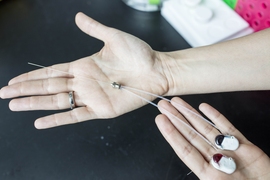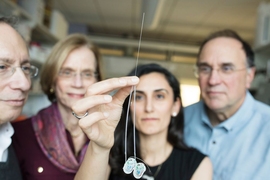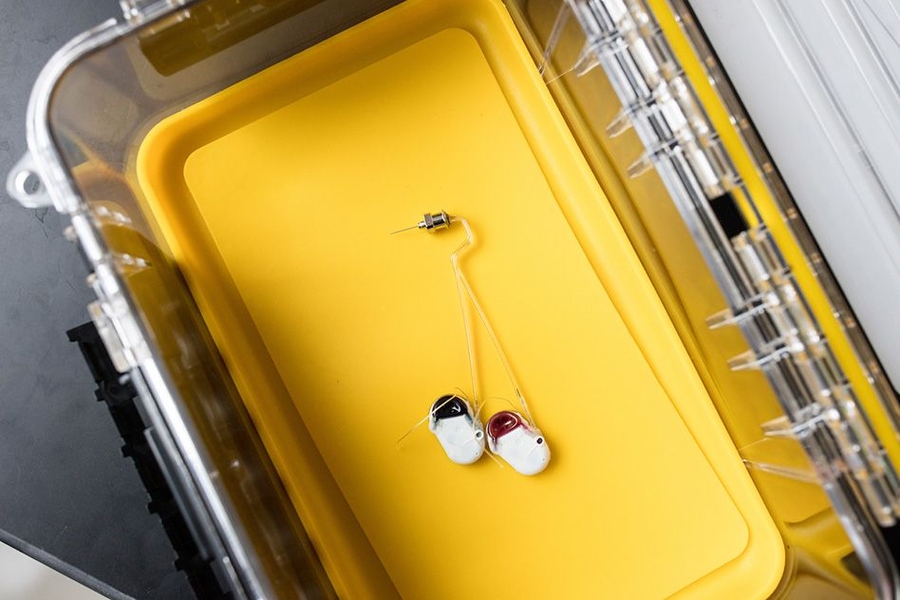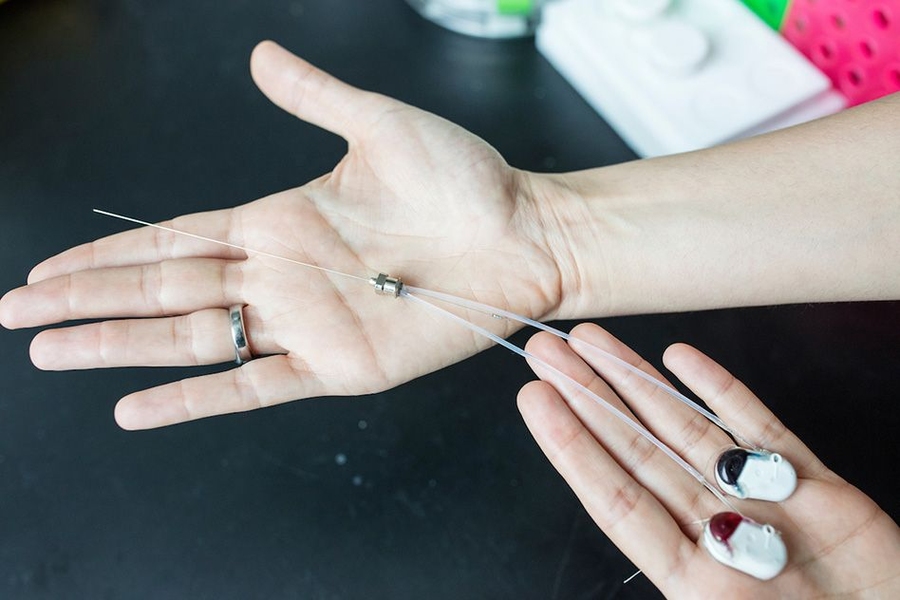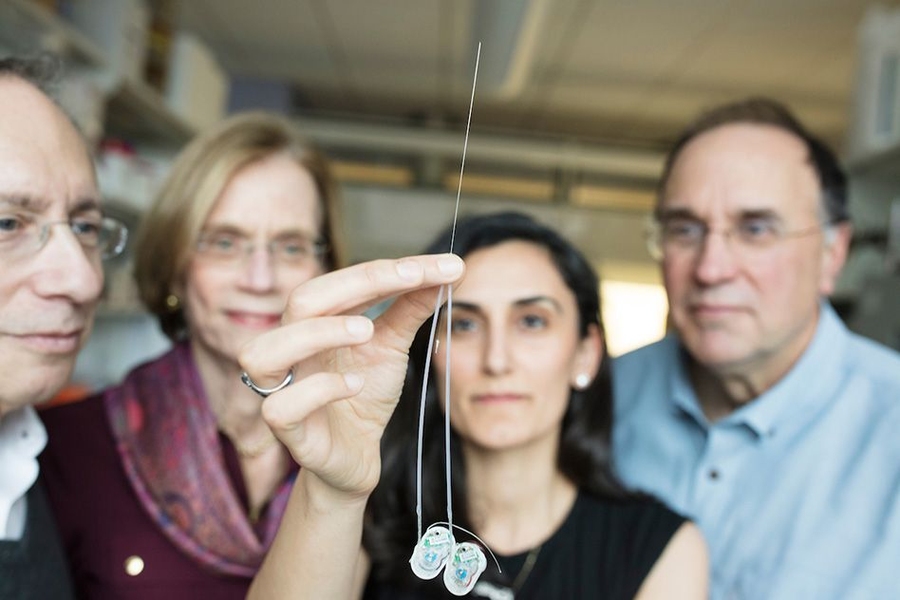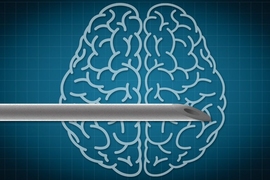MIT researchers have devised a miniaturized system that can deliver tiny quantities of medicine to brain regions as small as 1 cubic millimeter. This type of targeted dosing could make it possible to treat diseases that affect very specific brain circuits, without interfering with the normal function of the rest of the brain, the researchers say.
Using this device, which consists of several tubes contained within a needle about as thin as a human hair, the researchers can deliver one or more drugs deep within the brain, with very precise control over how much drug is given and where it goes. In a study of rats, they found that they could deliver targeted doses of a drug that affects the animals’ motor function.
“We can infuse very small amounts of multiple drugs compared to what we can do intravenously or orally, and also manipulate behavioral changes through drug infusion,” says Canan Dagdeviren, the LG Electronics Career Development Assistant Professor of Media Arts and Sciences and the lead author of the paper, which appears in the Jan. 24 issue of Science Translational Medicine.
“We believe this tiny microfabricated device could have tremendous impact in understanding brain diseases, as well as providing new ways of delivering biopharmaceuticals and performing biosensing in the brain,” says Robert Langer, the David H. Koch Institute Professor at MIT and one of the paper’s senior authors.
Michael Cima, the David H. Koch Professor of Engineering in the Department of Materials Science and Engineering and a member of MIT’s Koch Institute for Integrative Cancer Research, is also a senior author of the paper.
Targeted action
Drugs used to treat brain disorders often interact with brain chemicals called neurotransmitters or the cell receptors that interact with neurotransmitters. Examples include l-dopa, a dopamine precursor used to treat Parkinson’s disease, and Prozac, used to boost serotonin levels in patients with depression. However, these drugs can have side effects because they act throughout the brain.
“One of the problems with central nervous system drugs is that they’re not specific, and if you’re taking them orally they go everywhere. The only way we can limit the exposure is to just deliver to a cubic millimeter of the brain, and in order to do that, you have to have extremely small cannulas,” Cima says.
The MIT team set out to develop a miniaturized cannula (a thin tube used to deliver medicine) that could target very small areas. Using microfabrication techniques, the researchers constructed tubes with diameters of about 30 micrometers and lengths up to 10 centimeters. These tubes are contained within a stainless steel needle with a diameter of about 150 microns. “The device is very stable and robust, and you can place it anywhere that you are interested,” Dagdeviren says.
The researchers connected the cannulas to small pumps that can be implanted under the skin. Using these pumps, the researchers showed that they could deliver tiny doses (hundreds of nanoliters) into the brains of rats. In one experiment, they delivered a drug called muscimol to a brain region called the substantia nigra, which is located deep within the brain and helps to control movement.
Previous studies have shown that muscimol induces symptoms similar to those seen in Parkinson’s disease. The researchers were able to generate those effects, which include stimulating the rats to continually turn in a clockwise direction, using their miniaturized delivery needle. They also showed that they could halt the Parkinsonian behavior by delivering a dose of saline through a different channel, to wash the drug away.
“Since the device can be customizable, in the future we can have different channels for different chemicals, or for light, to target tumors or neurological disorders such as Parkinson’s disease or Alzheimer’s,” Dagdeviren says.
This device could also make it easier to deliver potential new treatments for behavioral neurological disorders such as addiction or obsessive compulsive disorder, which may be caused by specific disruptions in how different parts of the brain communicate with each other.
“Even if scientists and clinicians can identify a therapeutic molecule to treat neural disorders, there remains the formidable problem of how to delivery the therapy to the right cells — those most affected in the disorder. Because the brain is so structurally complex, new accurate ways to deliver drugs or related therapeutic agents locally are urgently needed,” says Ann Graybiel, an MIT Institute Professor and a member of MIT’s McGovern Institute for Brain Research, who is also an author of the paper.
Measuring drug response
The researchers also showed that they could incorporate an electrode into the tip of the cannula, which can be used to monitor how neurons’ electrical activity changes after drug treatment. They are now working on adapting the device so it can also be used to measure chemical or mechanical changes that occur in the brain following drug treatment.
The cannulas can be fabricated in nearly any length or thickness, making it possible to adapt them for use in brains of different sizes, including the human brain, the researchers say.
“This study provides proof-of-concept experiments, in large animal models, that a small, miniaturized device can be safely implanted in the brain and provide miniaturized control of the electrical activity and function of single neurons or small groups of neurons. The impact of this could be significant in focal diseases of the brain, such as Parkinson’s disease,” says Antonio Chiocca, neurosurgeon-in-chief and chairman of the Department of Neurosurgery at Brigham and Women’s Hospital, who was not involved in the research.
The research was funded by the National Institutes of Health and the National Institute of Biomedical Imaging and Bioengineering.

